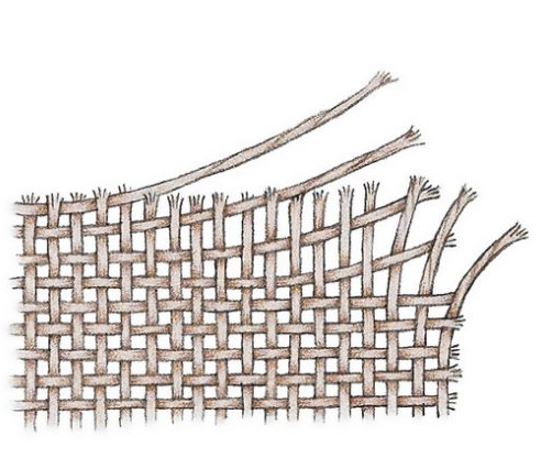Exploring the Differences Between Woven and Knit Fabric

Delve into the world of Woven vs. Knit Fabric. 🧷🌟Understand the differences and choose the right fabric for your sewing projects. A must-read for anyone looking to enhance their fabric knowledge!
In the wide world of sewing, various fabrics come into play—like linen, rayon, silk, wool, denim, cotton, and more. The surprise? Almost all fabrics neatly slot into two main categories: knit or woven.
Woven Fabric: Crafting Strength and Polish

Woven fabric is a bit like a checkerboard made by weaving two sets of yarn together. Imagine a loom, where vertical threads (warp) and horizontal threads (weft) cross each other, creating a strong textile. It looks a bit like a woven basket, with threads going under and over each other. Think of materials like cotton and denim—these woven fabrics are perfect for making sturdy shirts, skirts, and polished garments.
Characteristics of Woven Fabric:
- Robust Structure: Threads tightly woven provide durability, making woven fabrics ideal for sturdy projects.
- Durability: Even after numerous washes, woven fabrics maintain their original appearance.
- Ease of Sewing: They are easy to work with, making sewing projects a breeze for beginners and seasoned sewists alike.
- Wrinkle and Crease Potential: Woven fabrics have a tendency to wrinkle or crease, reflecting a characteristic that accompanies their durability and elegance.
- Lack of Stretch: Unlike knit fabrics, woven textiles don’t stretch, adding stability to their structure.
- Fraying Tendency: Woven fabrics may exhibit fraying tendencies, requiring attention to seam finishing for a polished look.
Examples of Woven Fabric:
- Cotton: Ideal for crafting breathable and durable garments, such as shirts and denim.
- Denim: Known for its sturdiness, commonly used in jeans and jackets.
- Linen: Light and breathable, perfect for warm-weather clothing like summer dresses.
- Wool Suiting: Offers a structured and polished look, suitable for tailored suits.
- Rayon: A versatile fabric used for various clothing items, including blouses and dresses.
Knit Fabric: Cozy Comfort Unveiled

Knit fabric is produced by interloping (or knitting) one set of yarn. This textile forms through the interplay of vertical and horizontal threads on the knitting loom, resulting in a flexible material that seamlessly adapts to your movements. In contrast to the ordered rows of woven fabrics, knits boast a more organic flow, making them suitable for crafting a variety of garments such as casual T-shirts, snug sweaters, leggings, and underwear. In the realm of comfort and versatility, knit fabrics warmly cater to your diverse wardrobe needs.
Characteristics of Knit Fabric:
- Soft and Cozy Comfort: Knit fabrics, crafted with loops of yarn, offer a delightfully soft and stretchy feel, providing an unparalleled level of comfort.
- Less Durable: While soft, knit fabrics are generally less structurally durable compared to their woven counterparts, making them ideal for garments prioritizing comfort over robustness.
- Difficult to Sew: While comfortable, knit fabrics can be a bit tricky to sew due to their stretchy nature. Zigzag stitches or a serger/cover stitch machine come to the rescue.
- Wrinkle Resistance: Knit fabrics generally resist wrinkles, maintaining a smoother appearance even after wearing.
- Stretchy Comfort: Knit fabrics are crafted with loops of yarn, offering a soft and stretchy feel, making them ideal for comfortable wear.
- Adaptable to Body Contours: The stretchiness of knit fabrics allows them to adapt to body contours, providing a flattering and comfortable fit for various body shapes and sizes.
Examples of Knit Fabric:
- Jersey: Soft and stretchy, commonly used for T-shirts and casual dresses.
- Rib Knit: Characterized by raised vertical lines, great for cuffs and collars in sweaters.
- French Terry: Terry cloth on one side and smooth on the other, often used in activewear.
- Spandex or Lycra Blends: Provide excellent stretch, commonly found in athletic wear.
- Interlock Knit: Double-knit construction, offering a smooth and sturdy fabric, often used in baby clothes and casual wear.
Choosing the Right Fabric for Your Project: A Simple Guide

Understanding the differences between woven and knit fabrics is essential in the world of sewing. Woven fabrics, known for stability and limited stretch, pair well with straight seams. On the flip side, knit fabrics love to stretch, requiring zigzag stitches or a serger/cover stitch machine. So, when picking your fabric, envision woven fabrics for structured garments like button-up shirts, tailored dresses, or sturdy skirts. On the cozy side, knit fabrics are perfect for crafting comfy hoodies, stretchy T-shirts, or relaxed sweaters. Match the fabric with your design vision, and your sewing journey becomes a breeze! 🧵✨
